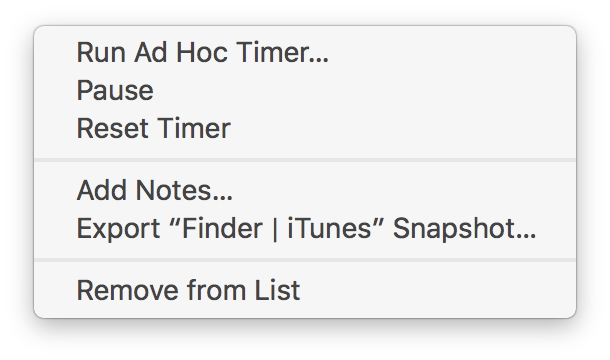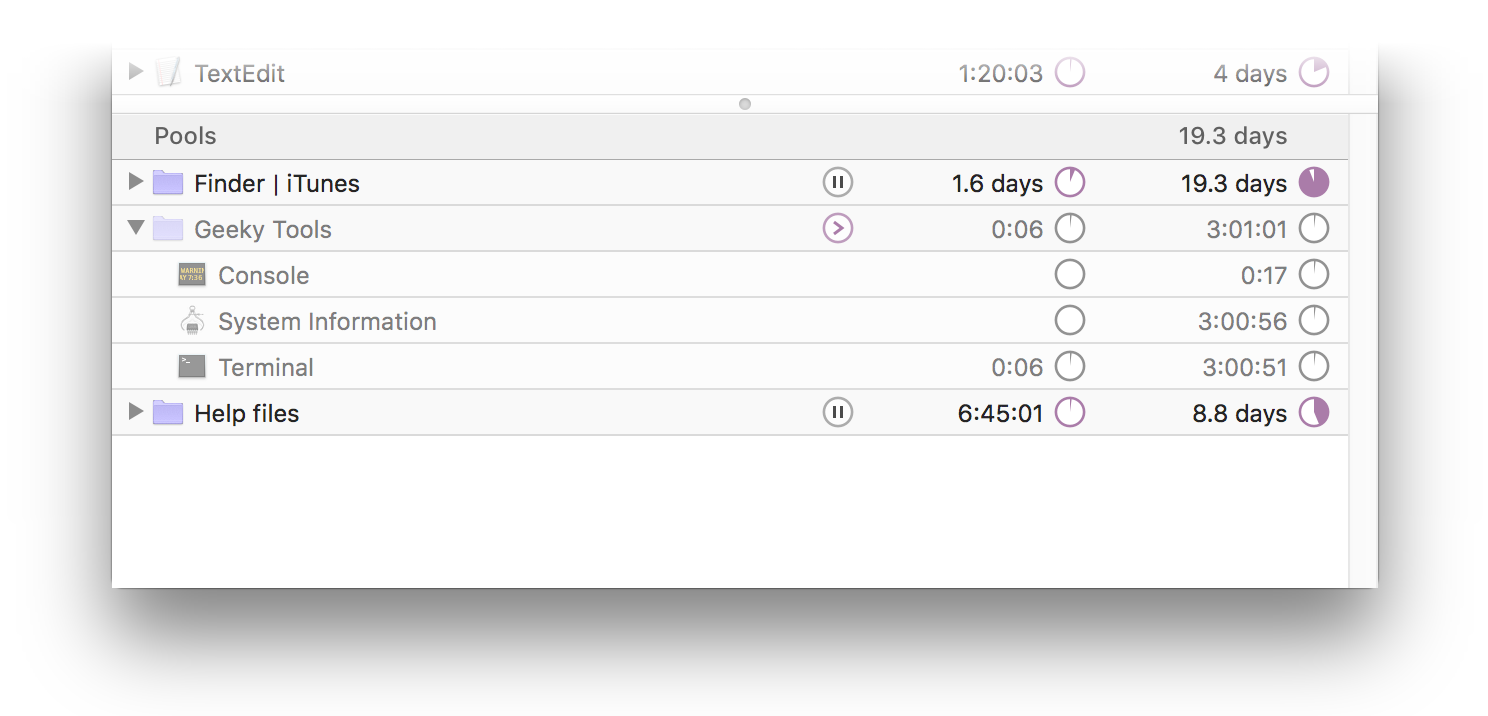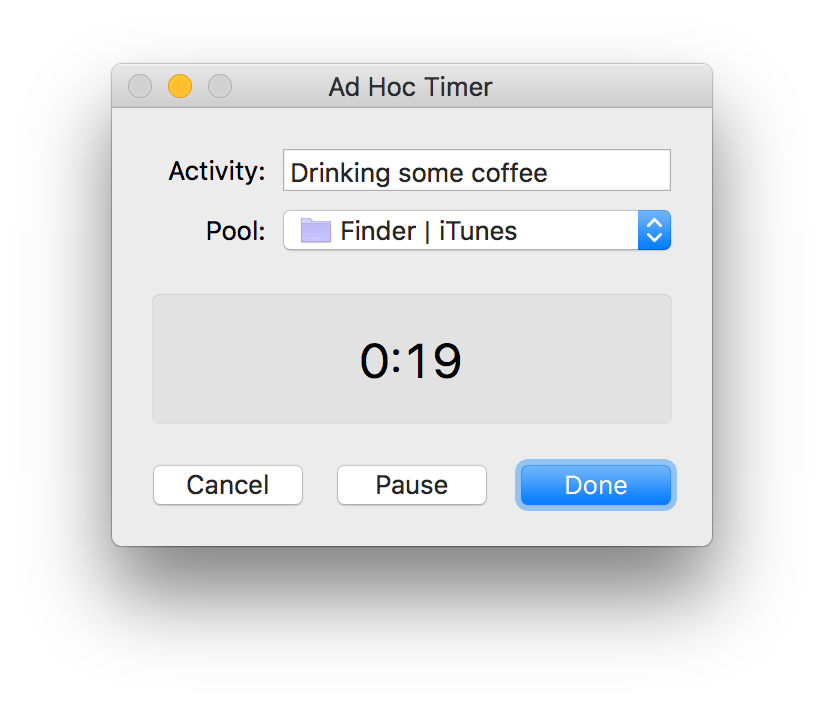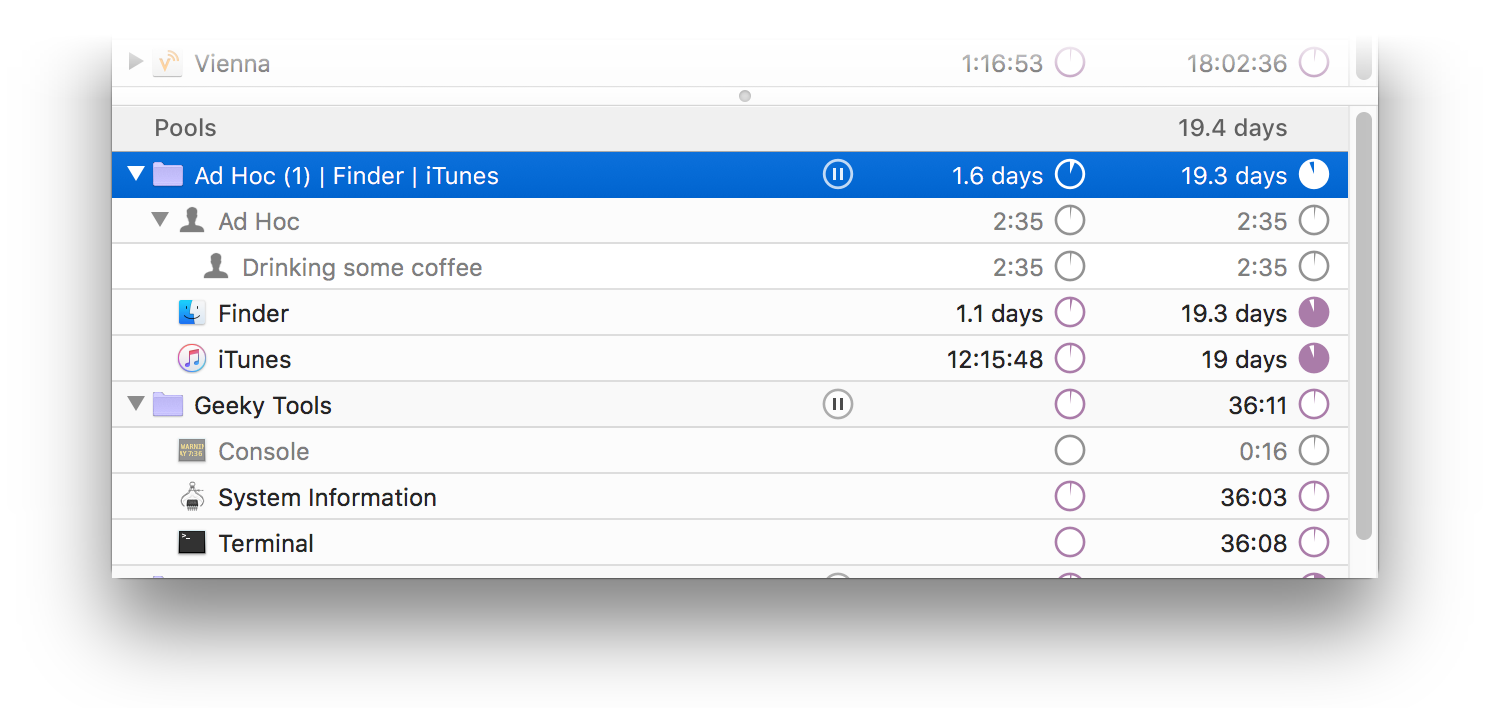One of Time Sink's most powerful features is the ability to create pools, which are simply groups of apps and/or windows that you'd like to monitor as one group. If you're a programmer, for instance, you might create a pool for all your Xcode work on a given project. If you're a graphic artist, you can group all graphic-related windows for a given client into one pool.
Once created, a pool will exist until you delete it—even if you don't currently have any of that pool's windows open. As soon as you do open a window that's been added to the pool, time tracking will resume.
Basics
To create a new pool, simply drag a window (or app) from the Apps section of the Organizer window into a blank area within the Pools section of that same window.
To add an app or window to an existing pool, simply drag it over the intended pool; the chosen pool will highlight, and you can then release your drag action. You can also place apps and windows in more than one pool at the same time—so iCal could be in both your Personal and Work pools, for example.
Pools can be renamed using the same methods as with Finder files and folders—highlight and press Return, or click-and-wiggle the mouse.
The following movie demonstrates creating new pools, adding to existing pools, and renaming pools.
To remove an item from a pool (or an entire pool), select it, then press Delete. This will not remove it from Time Sink's Organizer, just from the Pools section of the window.
Contextual Menus
As with the Apps section of the Organizer, the Pools section of Time Sink uses contextual menus to access certain features. If you right-click on the name of a pool, you'll see this contextual menu:

Using this contextual menu, you can run an ad-hoc timer (see below for more details on ad hoc timers), pause or resume a pool's time tracking, reset its timers, add notes, export a report for that pool (see Reports for more about reports), and remove the pool from the list.
Be aware that removing a pool from the list is a permanent thing—once gone, you'll have to manually recreate the pool, and you'll lose any historical data that you'd accumulated.
Another contextual menu appears when you right-click on any entry within a pool:

Reset timer and remove from list function as they do at the pool level, but only for the selected entry within the pool. Track all apps lets you create a global wildcard within the pool, so that any activity in any app will be counted in the pool. (If this mode is active, the contextual menu entry changes to "Track [name of app] only" to let you exit this mode. Finally, bring to foreground will do just what you'd expect, and bring the selected app to the foreground.
If an app within a pool isn't running, the Bring to Foreground option changes to Launch, so you can launch non-running apps directly from their pools.
Pausing Pools
Pools can be paused and resumed by clicking the small symbol to the right of their names. When paused, a pool's entries are grayed out, and no time accumulates.

If you pause pools, you must remember to manually restart them—Time Sink doesn't watch paused pools and remind you that they're paused.
Wildcards
Like window title filters in the top section of the organizer, you can also combine windows in Pools. Edit any window title's name within a pool, and you can use an asterisk (*) as a wildcard character, which will force similarly-named windows to be combined.
For example, Slashdot appends - Slashdot to the end of every window title. If you'd like a pool to track all the time you spend on any Slashdot page, first drag any Slashdot window into a pool (or create a new pool). Next, edit the window's name by selecting it and pressing Return, and change the title to * - Slashdot. The pool will now show activity for that window whenever you have any Slashdot page open, not just the page you dragged in.
Ad Hoc Timers
Ad hoc timers are Time Sink's way of letting you track tasks that aren't necessarily computer related. For instance, if you want to track how much time you take when you get your morning cup of coffee, you can start an ad hoc timer to count those minutes.
To create an ad hoc timer, first decide which pool you'd like to use for the timer. (Ad hoc timers can only be created within a pool.) Right-click on the pool's title and choose Run Ad Hoc Timer to open the ad hoc timer window. Type in the name of your activity, choose which pool you'd like to assign it to, and Time Sink will track the time:

Use the obviously-labeled buttons to cancel or pause the ad hoc timer; when you've completed your ad hoc activity, click the Done button to stop the timer. (The Ad Hoc timer window floats above all open windows, so you don't forget that you've started the timer.) The time spent on the ad hoc task will then appear in the chosen pool:

There can only be one active ad hoc timer at a time.
Tips and Tricks
Beyond the basics, here are a few tips for getting the most out of pools.
If there isn't any empty space in which to drag an item to create a new pool, drag it onto the Pools divider bar to accomplish the same result.
Click the small 'i' button next to each pool to create (or view) a descriptive note. You can use these notes to remind yourself of details about the pool, for example.
You can drag windows and apps from one pool to another.
A dragged-in app or window's timer normally starts at zero when it's added to a pool. However, if you hold down the Shift key before dropping the dragged item, the timer will start with the values for the app or window as shown in the Apps section of the Organizer. The pool's overall totals will then be calculated using those existing values.
When you remove a window or app from a pool, that pool's timers will not be reduced by the amount of time that window or app contributed to the pool's totals.
If you expand a pool in the Organizer window, it will also be expanded in the Activity Report window, assuming you have the Report pref for "Live activity report lists" set to either "active items shown in Organizer" or "all items shown in Organizer."
Using Time Sink's pools feature, you can group your tasks into a near-infinite number of configurations. Exactly how to use this feature is up to you, so feel free to experiment to find what works best for you.

